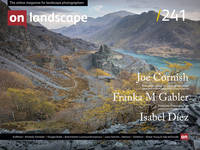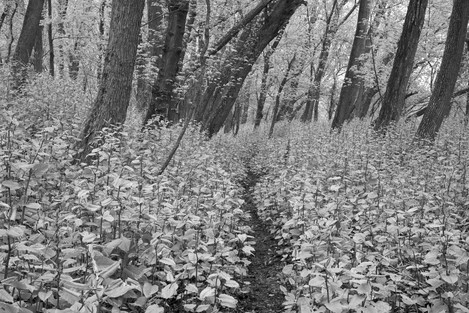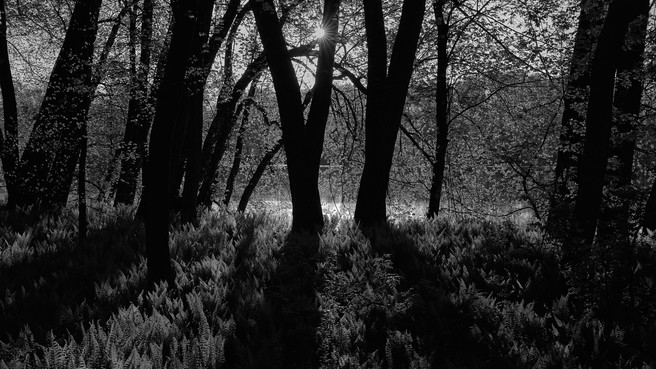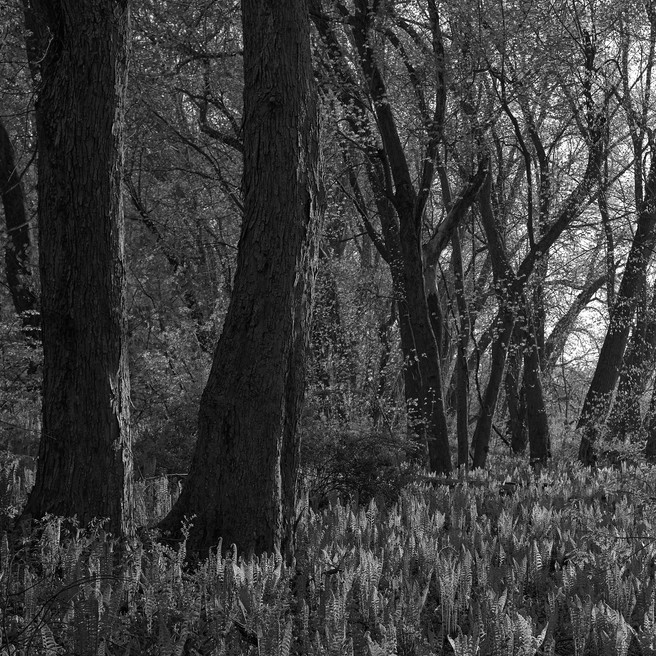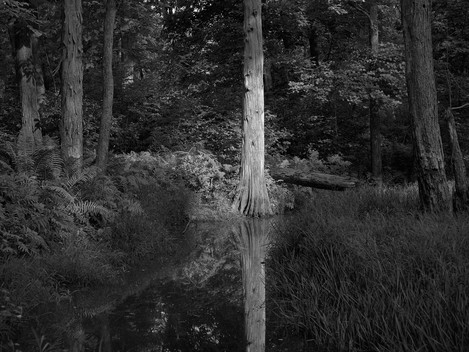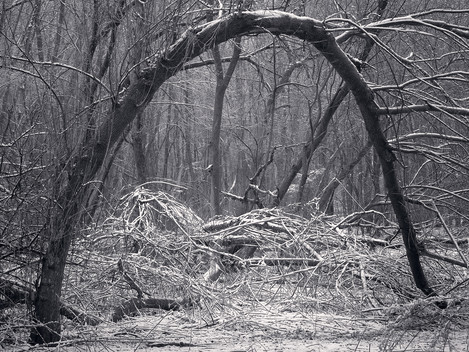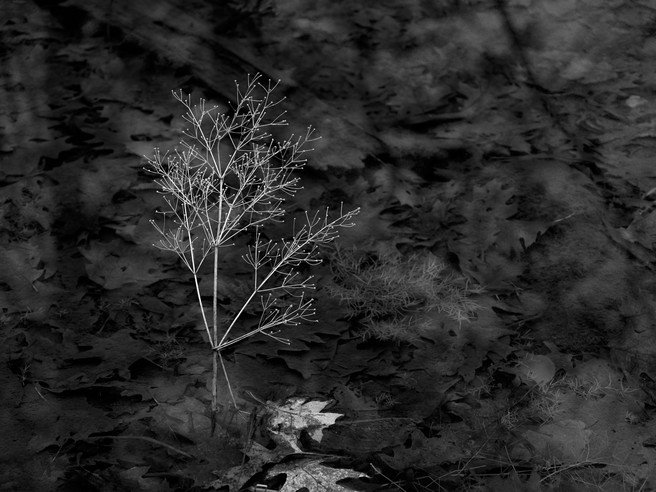The connective tissue of the rivers

Douglas Butler
Doug is a legal aid attorney living with his wife, Jen, in the Pioneer Valley of Western Massachusetts where he enjoys exploring the region, making images and writing.
How a global pandemic influenced my relationships with the outdoors, my region, my photography and myself during a yearlong forced sabbatical.
When I was very young, I found myself, along with my brothers, traipsing on the banks of anonymous brooks and creeks that fed nearby rivers, first the Hudson, later, after we moved, the Merrimack. These brooks and creeks were part of bottomlands—those river flanking, low-lying areas prone to flooding that lay like limbs akimbo alongside riverbeds. Bottomlands form the connective tissue, shuttling a watershed’s hilltop rains and spring snow melts back to the regathered run of a river. In these bottomlands, our summer play was raucous with our dares and shouts bouncing like the sun shining off the water. We explored shamelessly, trilling for whatever lurked in the water or the reeds or among the low hanging branches of leaning, mud-banked trees. There, frogs and peepers sang the summer into night and moonlight skittered on icy rivulets under winter’s bare branches. And when we moved again, to an urban area where no river ran, I still would find myself ankle deep in concreted streams, scattered with beer cans, tires and the occasional shopping cart, catching crayfish that darted about my bare feet, only to then let them slip from my fingers and swim on. Bottomlands, I discovered, were places where reverie among the thickets and culverts could overtake any need for solace and dank solitude hung hazy and inviting.
It comes as no wonder that now, decades later, I find myself living literally on the banks of the Connecticut River in Western Massachusetts’ Pioneer Valley and making its watershed not only my patch but my playground. These days, I can often be found ankle deep in unremarkable brooks and creeks, framing the bounce of light that darts and swims on, slipping from the fingers of my lens.
One product of this unprecedented year is my short e-folio—Bottomlands: Luminous/anonymous—that forms the basis of this article. Bottomlands was shaped by the pandemic and the strictures it placed on me—not just government restrictions on movement and masking, but the limitations it placed on my psyche, my mental and physical health and, quite frankly, my ability to muster the nerve to get out the door during a pandemic. The pandemic and my loss of employment had placed new boundaries on my photography—that is to say, altered the form within which I created images. For me, the creative photographer must commit to an exploration of the form that bounds their efforts. That is, we must commit unrestrainedly to probing our relationships with our environment and subjects; with our gear, technology and our practices; with place and the places we shoot; with weather and light; and, perhaps most importantly, with ourselves and our work and the process of creation. It was in the crucible of forced economic idleness and a global pandemic that I set about to do these things during my pandemic year.
In America, lockdowns come in many flavours with varying restrictions from state to state, and in the red states, even from county to county if not street to street. In Massachusetts, while many businesses were shut down, mask mandates were put in place and strict limitations were imposed on the essential businesses that were allowed to remain open, parks, wildlife refuges and sanctuaries and other recreational areas remained open. In fact, people were encouraged by government and local media to visit these areas, practising social distancing while communing with nature—perhaps not surprising in the home state of Thoreau!
Looking back, as is often the case, the infiltration of the masked masses to my usual haunts opened up a whole new world not only in the anonymous (and not so anonymous) places where I made these images but other lesser known lands set aside for recreation or as refuges, sanctuaries, land trusts and the like. These include state forests and parks, bird sanctuaries, wildlife sanctuaries and refuges, historic sites and conservation areas situated on public land, public/private cooperatives, land trusts and even outright private land accessible to the public (no right to roam in the States!). The scene in The Way In, for instance, with its horse path among slanted trees and abundant undergrowth, sits on a narrow strip of land between massive potato fields to the west and the Connecticut River to the east. The stooping trees, seeming bowed in reverence to the sustaining river, call to mind the skewed world I was inhabiting at the time. The tangle of undergrowth mirroring the throng of chaotic forces lined up all around me, choking yet mesmerising in their unwavering uniformity. And the path. Narrow and diminishing, thronged on either side, yes, but a gift of hopefulness and comfort. A way in and onward, should you trust it in the face of its pin-point finiteness disappearing in your eye.
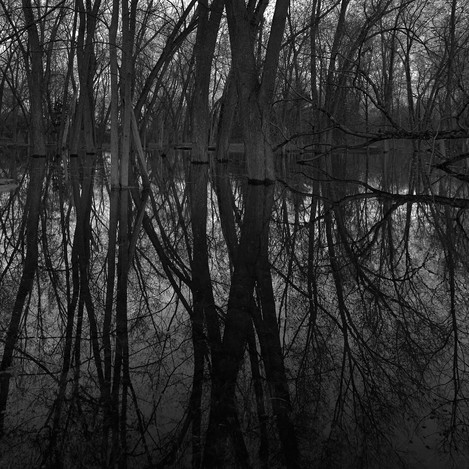
Knee Deep
Knee Deep was captured before the pandemic but is included here as an example of the conditions present in the area during spring flooding.
This scene sits in a nameless area, shared by horseback riders, fishermen and amblers about two miles from my doorstep and is part of the Connecticut River Greenway State Park, a series of 8 parks dotting the banks of the river. This bit of the park became a refuge for me during my pandemic year. The location is subject to regular flooding and bounded on one side by industrialised farming and yet, people have chosen to tuck it away for conservation and enjoyment—a hopeful gesture on the banks of a river. When the backlit ferns in Light Lifting filled in the understory a little way up the horse path, that optimism sprung up in me. Though unknown to me, I was months from returning to work and the worst of the pandemic was only hinted at when I made this image.
Like most people, my optimism wasn’t unbounded during this difficult time nor was it left alone by complication, self-doubt and wavering. Arched Arrival, for me, captures the overarching complexity of the bottomlands flanking the river and the vagaries that complicate all matters of living and life, including mine. Taken about five miles downriver from the previous images, this setting is much more wild, complicated and knotty, in part due to the fact that flooding here is considerably more regular and severe rendering the landscape a tangle of down-beaten foliage, muddy culverts and impenetrable thickets. But even here, spring snow provides the necessary illusion that matters may not be as complex as they appear and pattern and cohesion can still be found amidst the disorder and confusion of life. The arched tree frames a tableau rendered cognisable by the addition of a single element—snow—calling to mind that, for me, outdoor photography was more often than not, if not the single element, a significant one, rendering for me the chaotic pandemic world into a semi-recognisable place. Many were the time that I was “out and about” with my camera that I almost forgot the strife befalling the world and myself and my family and loved ones—that single element rendered my world a little more normal than it really was.
The extensive flooding in this area is the result of the confluence of the Mill River and the Connecticut River. During spring, snowmelt from Vermont and New Hampshire ambles south to the Atlantic down the Connecticut River, raising its banks and flooding the bottomlands flanking it.
These next images, Eponymous/anonymous 1 to 5, were all captured in a nameless gulley, about four miles north of the horse path and ferns in the morning sun. This channel amounts to not much more than a dank, large trench carved out by the Sugarloaf Brook on its way to the nearby Connecticut River. To me, the ghostly light, scrabbly undergrowth, untended deadfalls and unwitnessed decay and entropy of this gulch are reminiscent of my childhood explorations in the solitude of the muddy bottomlands near where I grew up. This feeling was enhanced by the baseball field rendered dormant by the pandemic that sat next to this undistinguished ravine. Baseball was a huge part of my youth and thoughts of the games unplayed during the pandemic as I ambled around this gulley became a mental tangle of understory and bramble and sweet decay of time passing as I made these images. Not all images I made in these bottomlands evoke melancholy despite the decay evident in them.
For me, Calliphaea, with its single stalk of an unremarkable weed, jutting from rot and reflection evokes a certain hopefulness and optimism, though it lacks the wash of morning light and vibrancy of spring seen elsewhere in these images. Taken in a flooded basin near Cranberry Pond, a glacial pond that became inundated with people trying to escape the confinements of the pandemic. Cranberry Pond is a place where I have explored endlessly with my camera, literally making thousands of exposures in my early days of exploring the form of creative, expressive outdoor photography. The influx of pandemic invaders to my stomping grounds forced me to explore further the region surrounding the pond leading me to making Overreach stood in a dry, rock strewn creek bed south of the pond. The slanting deadfall juxtaposed with juts of shimmering saplings over the once flowing stream evokes the promise that all things will pass even in the face of cyclical want and the ever-present entropy of life. These feelings are present as well in the flooded Mill River’s grasses and cascading bank of foliage back dropping juts of deadwood reclaimed by the muddy waters seen in Subsumed. Abstraction and pooling light set out in Downcast and Ferned Gulley, respectively, round out this collection of images of anonymous bottomlands, the former fractalising a puddle reflected tree, the latter a small bowl of light in a banquet of shadow and murk.
My forced sabbatical ended, thankfully, in mid spring 2021. All told, I was out of work for 54 weeks. This essay aside, I did not spend all that time in the muck and mire of my local bottomlands. I surveyed the Pioneer Valley voraciously, exploring it and my relationship with creative outdoor photography with a ravenous appetite. I nurtured my reverence for places of beauty if not unique to the Pioneer Valley, exemplified in its parks and refuges, its farms and forests. I discovered new places of exceptional and distinctive beauty, shaped by this area’s unique history and singular geologic past. Places like the Poland Brook Wildlife Refuge, 664 acres of land managed, in part, to improve habitat for woodcocks, the Zoar Gap, a steep valley cut by the Deerfield River in the foothills of the Berkshires and, among many others, Whetstone Wood Wildlife Sanctuary, Massachusetts’ largest nongovernment managed wildlife sanctuary at almost 2,500 acres. I explored waterfalls, lichen covered cliff walls, hilltop orchards, countless farms, forests, fields and furrows. I stood in spring snow, summer downpours, autumn’s robes of gold and red and the frigid poverty of bare winter trees. While I would gladly exchange all that for a world without Covid, there is nothing else I would take in trade.
- The Way In
- Light Lifting
- Sentinels
- Arched Arrival
- I’m Ready For My Close Up
- Knee Deep
- Calliphaea
- Overreach
- Subsumed
- Downcast
- Ferned Gulley

